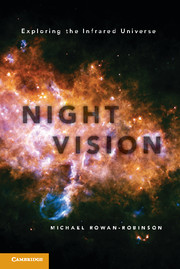Book contents
- Frontmatter
- Contents
- Preface
- 1 Introduction
- 2 William Herschel Opens Up the Invisible Universe
- 3 1800–1950
- 4 Dying Stars Shrouded in Dust and Stars Being Born
- 5 Birth of Submillimetre Astronomy
- 6 The Cosmic Microwave Background, Echo of the Big Bang
- 7 The Infrared Astronomical Satellite and the Opening Up of Extragalactic Infrared Astronomy
- 8 The Cosmic Background Explorer and the Ripples, the Wilkinson Microwave Anisotropy Probe and Dark Energy
- 9 Giant Ground-Based Near-Infrared and Submillimetre Telescopes
- 10 The Infrared Space Observatory and the Spitzer Space Telescope
- 11 Our Solar System’s Dusty Debris Disk and the Search for Exoplanets
- 12 The Future
- Epilogue
- Notes
- Credits for Illustrations
- Glossary
- Further Reading
- Bibliography
- Name Index
- Subject Index
10 - The Infrared Space Observatory and the Spitzer Space Telescope
The Star-Formation History of the Universe
Published online by Cambridge University Press: 05 March 2013
- Frontmatter
- Contents
- Preface
- 1 Introduction
- 2 William Herschel Opens Up the Invisible Universe
- 3 1800–1950
- 4 Dying Stars Shrouded in Dust and Stars Being Born
- 5 Birth of Submillimetre Astronomy
- 6 The Cosmic Microwave Background, Echo of the Big Bang
- 7 The Infrared Astronomical Satellite and the Opening Up of Extragalactic Infrared Astronomy
- 8 The Cosmic Background Explorer and the Ripples, the Wilkinson Microwave Anisotropy Probe and Dark Energy
- 9 Giant Ground-Based Near-Infrared and Submillimetre Telescopes
- 10 The Infrared Space Observatory and the Spitzer Space Telescope
- 11 Our Solar System’s Dusty Debris Disk and the Search for Exoplanets
- 12 The Future
- Epilogue
- Notes
- Credits for Illustrations
- Glossary
- Further Reading
- Bibliography
- Name Index
- Subject Index
Summary
The enormous success of IRAS stimulated both the European Space Agency (ESA) and NASA to develop new space infrared observatories that would follow up the wealth of discoveries about the infrared universe made with IRAS.
Early in February 1983, the European Space Agency met to select a new medium-sized astronomy space mission. Peter Clegg was able to place on the table at the meeting the first scan around the sky from IRAS, and its quality was sufficient to convince the European Space Agency to select the Infrared Space Observatory (ISO). The idea for a European infrared space observatory had been first proposed in 1979. ISO was finally launched in November 1995 with a planned life of 18 months (Figure 10.1). In fact, its helium coolant lasted until April 1998, almost a year longer than expected.
ISO had a camera, ISOCAM, led by Catherine Cesarsky and a spectrometer, SWS, led by Thijs de Graauw, working at the near- and mid-infrared wavelengths (3–20 microns); and a camera, ISOPHOT, led by Dietrich Lemke and a spectrometer, LWS, led by Peter Clegg, working at far-infrared (40–160 micron) wavelengths. The two cameras also had smaller low-resolution spectrometers as part of their capability. The spectrometers of ISO were especially powerful in unravelling the nature of the dust around stars and in interstellar space, and in probing young stars in the process of formation.
- Type
- Chapter
- Information
- Night VisionExploring the Infrared Universe, pp. 132 - 154Publisher: Cambridge University PressPrint publication year: 2013



